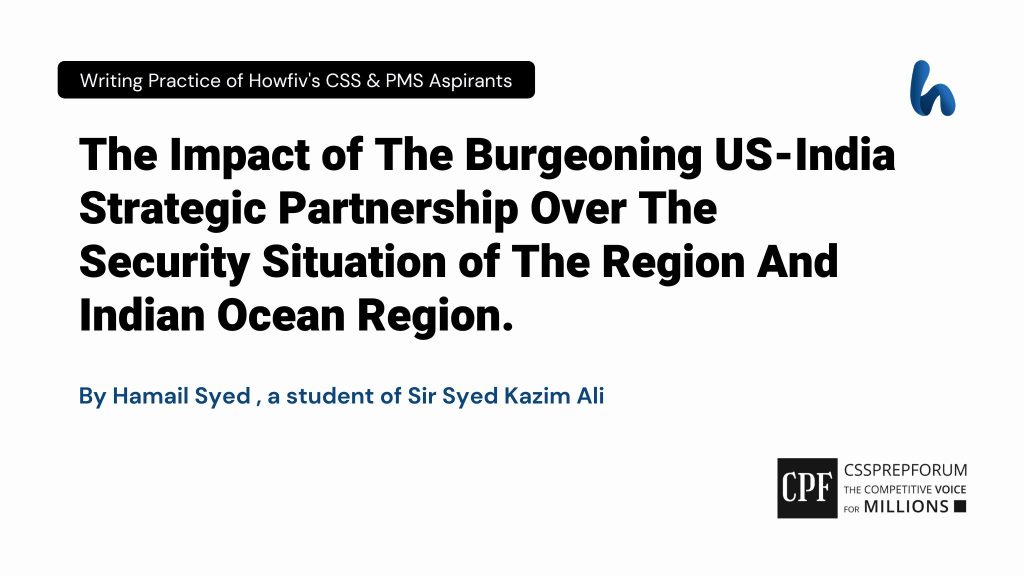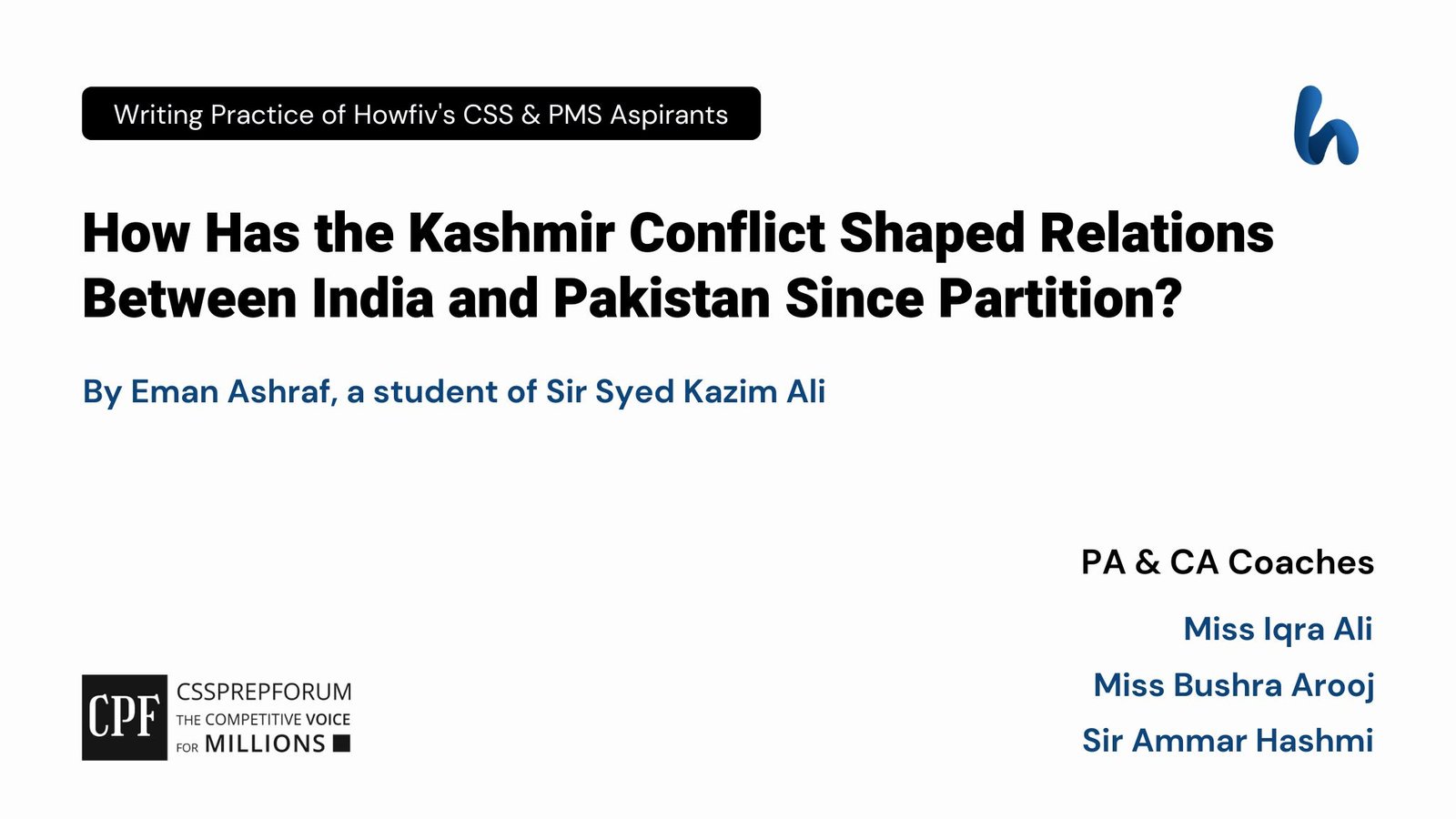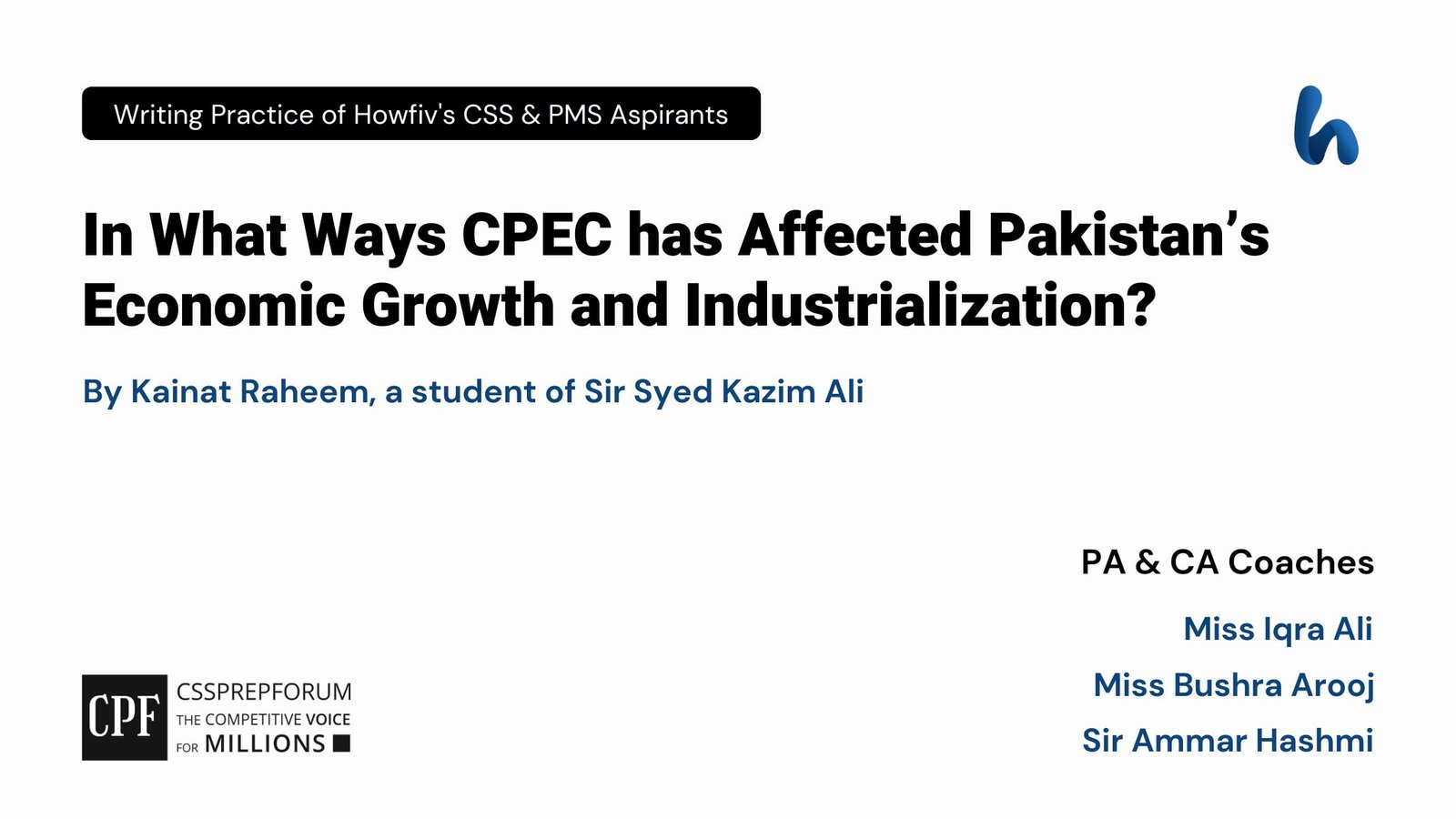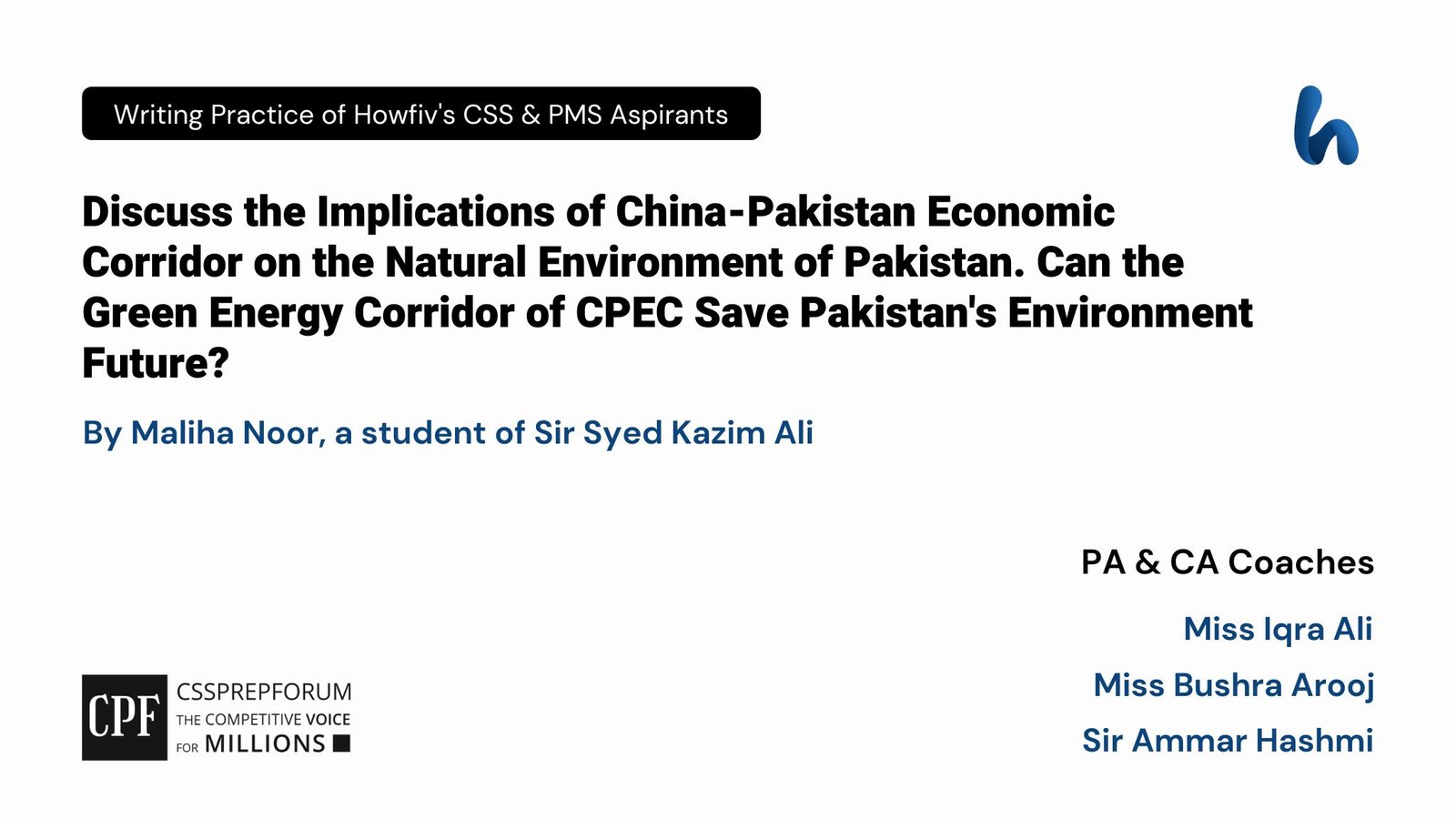US-India Strategic Partnership Impact on IOR | | DailyWriteups | Opinions
The following article, “The Impact of The Burgeoning US-India Strategic Partnership Over The Security Situation of The Region And Indian Ocean Region.”, is written by Hamail Syed, a student of Sir Syed Kazim Ali. Moreover, the article is written on the same pattern, taught by Sir to his students, scoring the highest marks in compulsory subjects for years. Sir Kazim has uploaded his students’ solved past paper questions so other thousands of aspirants can understand how to crack a topic or question, how to write relevantly, what coherence is, and how to include and connect ideas, opinions, and suggestions to score the maximum.

Outline
1- Introduction
2-The significance of the Indian Ocean for the states
3-An overview of the motives of the US and India behind their strategic partnership
- ✓The motives of the US in the Indo-US strategic partnership
- ✓The motives of India in the Indo-US strategic partnership
4-A glimpse of the US-India strategic partnership
- ✓Indo-US Civil Nuclear Deal
- ✓General Security of Military Information Agreement (GSOMIA)
- ✓Logistics Exchange Memorandum of Agreement (LEMOA)
- ✓Basic Exchange and Cooperation Agreement (BECA)
- ✓2+2 Ministerial Dialogue
- ✓The Quadrilateral Security Dialogue
5-The impacts of the Indo-US strategic partnership on the security situation in the South Asian region and the Indian Ocean region
- ✓Security dilemmas in South Asian states
- ✓Complexity in power balancing in South Asia
- ✓Shift in regional alliances
- ✓Change in India’s policy over the Iran nuclear issue
- ✓Change in the foreign policies of the states
- ✓ India’s aggressive posture in the region
- ✓Increase in maritime competition in the Indian Ocean Region
- ✓The Indian Ocean as the Nuclear Ocean
6-Suggestions to improve the security situation in the South Asian region and the Indian Ocean region to overcome the impacts of the Indo-US strategic partnership
- ✓To strengthen defence ties with other regional powers like Russia and China.
- ✓To form strategic partnerships with one another.
- ✓To promote the blue economy by building maritime infrastructure and technology.
7-Critical Analysis
8-Conclusion

Answer to the Question
1-Introduction
The United States (US) has considered India a linchpin in a new strategy while focusing on Asia. In this context, Washington’s new strategy forges a strategic partnership with New Delhi based on two objectives. First, the US wants to give India a solid defensive position against China. Second, the US considers China a revisionist power that can be balanced by its strategic partnership with India. Moreover, under this partnership, the two countries have signed multiple agreements that cover different domains, including trade, technology, and defence. Certainly, Indo-US ties have many impacts on the South Asian region and the Indian Ocean region. Delving into the consequences, the most vital effect of this partnership is that it has created a security dilemma in the South Asian region. Further, India has become aggressive towards its neighbours, as evidenced by the Balakot incident. Besides that, new ties have been made in the region. In addition, the US-India nexus also affects the Indian Ocean region, as countries are in a competitive arms race to gain control of the ocean, hence converting the Indian Ocean into a nuclear ocean. In conclusion, Washington and New Delhi’s strategic partnership pushes the region towards instability and power balancing.
2-The significance of the Indian Ocean for the states
Delving into the significance of the Indian Ocean Region (IOR), the large portion of oil flow from the Persian Gulf to the world augments the importance of the IOR. First, the sea lines of communication help the smooth transfer of goods through the region. Second, it has the most important choke points; for example, the Malacca Strait is imperative for China as it connects the South China Sea. Likewise, the Strait of Djibouti links the Indian Ocean with the Red Sea. Hence, the Indian Ocean is critical for states, providing connectivity, transportation, and communication facilities. Alfred Thayer Mahan, an American maritime strategist, said, “Whoever controls the Indian Ocean will dominate Asia; the world’s destiny will be decided on its waters.” Therefore, nation-states indulge in dominating the region to achieve their national interests.
3-An overview of the motives of the US and India behind their strategic partnership
The motives of the US in the Indo-US strategic partnership
Considering the prevailing situation, the United States’ (US) dominance in the current global order has been challenged by China’s economic rise in the twenty-first century. Therefore, the US wants to make allies and strategic partners in different regions to counter global threats. For this purpose, in South Asia, the US has created partnerships with India to counter the rising influence of China in Asia-Pacific (APAC) and the Indian Ocean Region (IOR) and to maintain its dominant status in the world. Moreover, the US believes that India has the potential to actualize the US Indo-Pacific Strategy because India has a large economy and territory.
The motives of India in the Indo-US strategic partnership
Like the US, India also has some motives behind its burgeoning ties with the US, as it aims to be a regional hegemon. Therefore, New Delhi wants to quench its thirst for dominance by increasing its military capabilities through the US-India strategic partnership. India views its ties with the US as a win-win situation for both states.
4-A glimpse of the US-India strategic partnership
Keeping in view the dynamics of the new world order, Washington wants to achieve its aims by designing a toolbox that contains strategies for hedging against rising Beijing power to maintain its preponderance in the Asia-Pacific (APAC) through its ally, India. It is pertinent to highlight that during the Cold War, the relationship between New Delhi and Washington was not strong because of their divergent views over the United States’ rivalry with the USSR. However, strategic convergence between the two states began in the mid-1990s. As a result, numerous agreements have been signed between the two countries. Some crucial contracts between the two allies are highlighted below.
Indo-US Civil Nuclear Deal
To begin with, the Indo-US Civil Nuclear Deal, signed in 2005, is one of the central pillars of the strategic partnership between the two states. The deal unofficially recognizes India as a de-facto nuclear weapon state (NWS) and removes technological restrictions on India, thereby allowing it to have access to nuclear technologies. Additionally, the deal continues to undermine the global nuclear non-proliferation regime. Hence, through this agreement, the defence ties between the two states have strengthened to fulfil their interests.
General Security of Military Information Agreement (GSOMIA)
Besides the Civil Nuclear Deal, Washington and New Delhi signed another vital agreement in 2002, the General Security of Military Information Agreement (GSOMIA). The agreement enables the sharing of classified military information between the two countries. Thus, this agreement has increased New Delhi’s military capabilities compared to other South Asian states.
Logistics Exchange Memorandum of Agreement (LEMOA)
Furthermore, in 2016, the US and India signed a Logistics Exchange Memorandum of Agreement (LEMOA), allowing forces from the two countries to use each other’s military bases for reinforcement, supplies, and mechanical repairs. The LEMOA provides extra privileges to the Indian military; therefore, the US-India partnership is heading towards its target of making India’s defence system strong enough to counter China in the region.
Basic Exchange and Cooperation Agreement (BECA)
In addition, the two states signed an agreement in 2020 titled the Basic Exchange and Cooperation Agreement (BECA). It further strengthens Indo-US strategic cooperation. Ostensibly, the deal provides India access to sensitive information in real-time through US geospatial intelligence. This agreement helps India access high-quality Global Positioning System (GPS) technology, which can enhance the accuracy of its guided weapons, such as missiles and armed drones. Thus, the US-India strategic alliance helps India strengthen its defence, enforcing the security dilemma in the region.
2+2 Ministerial Dialogue
Likewise, in continuation of the growing strategic convergence, India and the US held their first 2+2 Ministerial Dialogue in 2018. Both sides called the dialogue a “Reflection of the shared commitment,” wherein the two countries reaffirmed their strategic cooperation in defence, security, and technology in the Indo-Pacific region and beyond. The first dialogue was followed by three subsequent 2+2 dialogues in 2019, 2020, and 2022, in which increasing strategic cooperation and strengthening people-to-people ties were discussed. The US and India continued reaffirming their collaboration on the US policy of a free and open Indo-Pacific. The joint statement of the fourth US-India 2+2 Ministerial Dialogue, held on April 11, 2022, reflects reaffirmations from both countries for building an advanced and comprehensive bilateral defence partnership. It acknowledged the importance of extending collaboration in emerging defence domains, including Artificial Intelligence (AI), space, and cyber. As a result, the US and India’s influence and military presence increase not only in the South Asian region but also in the Indian Ocean region.
The Quadrilateral Security Dialogue
Lastly, Quad or Quadrilateral Security Dialogue is a diplomatic network between the US, India, Australia, and Japan. Basically, it was established in 2007; Japanese Prime Minister Shinzo Abe was the first to pitch the idea for its formation. The main motive behind the Quad is to keep the strategic sea routes in the Indo-Pacific free of any military or political influence. It is evidently seen as a strategic grouping to reduce Chinese domination. So, through Quad, the US and India aim to increase their dominance in the Indian Ocean Region (IOR).
5-The impacts of the Indo-US strategic partnership on the security situation in the South Asian region and the Indian Ocean region
As every action manifests its impacts afterwards, the Indo-US strategic alliance also has inevitable and dire influences on the Indo-Pacific region and beyond. Here, light has been thrown on some of the impacts of the Indo-US strategic partnership on the security situation in the South Asian region and the Indian Ocean region.
Security dilemmas in South Asian states
First, Indo-US nexus and defence cooperation have pushed the South Asian region into a security dilemma, where an increase in one state’s security leads other states to fear for their own security. Therefore, other states in the South Asian region also try to increase their military strength to counter powerful states. According to the Congressional Research Service (CRS) report, 2023, “The US delivered its major arms to India, such as aircraft turbofans, Harpoon anti-ship missiles, and Fire finder counterbattery radars.” Such weapons boost the military might of India, thus posing threats to its neighbouring states like Pakistan. As a result, Pakistan feels insecure and indulges in strengthening its security by importing weapons like fighter aircraft, warships, missiles, etc. Hence, Indo-US strategic and defence ties have increased the power asymmetry between the two archrivals, India and Pakistan, intensifying the security dilemma in South Asia.
Complexity in power balancing in South Asia
The second impact of US-India strategic ties is the complexity of power balancing. Basically, a nation-state requires power and strength to survive in an anarchic international order. If a country fails to acquire power, it can become subservient to powerful countries; ultimately, weak states lose their autonomy and security. Therefore, an international anarchic structure compels nation-states to maximize their power. Moreover, power balancing is the primary goal of all countries, as strategic gain by one state directly affects another state. Indeed, the US-India strategic partnership and civilian nuclear cooperation have disturbed South Asia’s strategic balance of power. For example, the rise of India as a regional power and its increasing influence in Afghanistan pose severe threats to Pakistan’s security. In response to the US-India civilian nuclear deal, Pakistan has increased its cooperation with China in the nuclear energy field. In this way, the US-India nuclear deal has severely affected regional and global security as an arms race is going on in the region to attain a balance of power.
Shift in regional alliances
The third ramification of the Indo-US nexus is the shift in regional alliances as South Asian countries try collaborating with other nations. The manifestation of new regional bonds can be seen in Islamabad and the Kremlin’s emerging cooperation. The two countries have tried to decrease their trust deficit in the last decade. Moreover, Russia endorsed Pakistan for joining the Shanghai Cooperation Organization (SCO) in 2011. The inclusion of Pakistan in the SCO in 2017 has failed the Indian effort to isolate Pakistan. In addition, Russia and Pakistan inked the Security Training Agreement in 2018, which allows the training of Pakistani military officers in Russia for the first time. Hence, it is evident that the relationship between Pakistan and Russia has enhanced compared to the past in response to US and Indian relations. Along with emerging Pakistan and Russian ties, Islamabad also tries to rebuild its relations with Tehran. Indeed, the US-India strategic partnership and defence deal have brought Pakistan and Iran closer to each other, as both countries have signed vital agreements. For example, on May 18, 2023, Pakistan’s Prime Minister and Iran’s President inaugurated the border market. Moreover, both leaders inaugurated an electricity transmission line to provide Iranian electricity to Pakistan’s remote regions. In brief, the US-India alliance has encouraged the South Asian states to strengthen their ties with other countries and regions. The manifestation of this situation can be seen in the growing relationship between Russia-Pakistan and Pakistan-Iran. In short, the US-India nexus caused the shift in regional alliances.
Change in India’s policy over the Iran nuclear issue
Fourth, the India-Iran relationship has undoubtedly remained positive throughout history. Both countries strengthened economic, energy, education, and science cooperation and launched a strategic partnership in 2003. However, due to the escalating India’s ties with the US, the policy of India over the Iran nuclear issue slowly shifted towards the US. For instance, India voted with the US during the 2005-2006 International Atomic Energy session. Moreover, India has fully supported the international sanctions against Iran. It is pertinent to note that the US is against the Iran-Pakistan-India (IPI) Gas Pipeline Project because the project will benefit Iran economically, and the US wants to weaken Iran due to Israel. So, due to the Indo-US partnership, India has abandoned its participation in the IPI project despite Iran’s continuous efforts to complete it.
Change in the foreign policies of the states
Fifth, the US-India strategic partnership and civilian nuclear deal have brought a significant shift in the foreign policies of South Asia’s states. For example, Pakistan’s foreign policy has changed from geo-economic to geo-strategic as it has strengthened its relations with China and pursued building close ties with Russia, Iran, Cuba, Uzbekistan, etc. Moreover, China has also adopted a new foreign policy law. According to the Ministry of Justice of the People’s Republic of China, the National People’s Congress approved a new foreign policy law in June 2023 to respond to a growing number of sanctions imposed by the US and its allies, and it went into force on July 1, 2023. The law incorporates China’s goals, such as the Global Security Initiative, the Global Development Initiative, and the Global Civilization Initiative, into its foreign policy. The newly enacted foreign relations law emphasizes security-driven foreign relations and economic interests. The above discussion shows that growing US-India ties influence the foreign policies of South Asian nations.
India’s aggressive posture in the region
Sixth, unfortunately, the Indo-US strategic partnership adversely impacts strategic stability in South Asia, as India ranks among the world’s top arms importers. This adds to the conventional imbalance among states in the South Asian region. Furthermore, it also makes India aggressive towards its rival states, like Pakistan. For example, on February 29, 2019, Indian Air Force (IAF) planes violated Pakistan’s airspace and dropped their payload in the Balakot area. The incident highlights India’s aggressive behaviour as an irresponsible NWS. Additionally, in August 2019, the BJP government in India changed the special status of Occupied Jammu and Kashmir by splitting and incorporating it as two separate union territories, Jammu and Kashmir and Ladakh, by suspending Article 370 and Article 35-A of the Indian Constitution. This fact shows that the US’s unconditional support for India has made it aggressive and irresponsible.
Increase in maritime competition in the Indian Ocean Region
Seventh, the Indian Ocean region has unquestionably become a hotbed of increasing power struggles among countries like China, the US, and India. The states are constantly competing to raise their naval superpower in the Indian Ocean Region (IOR) to gain their national interests. In addition, Washington and New Delhi have been trying to dominate the Indian Ocean Region with a military presence, but they are being contested by China. For example, the United States and India announced the latest maritime cooperation agreements, which allow the US Navy to use Indian ports as logistics centres. On the flip side, Beijing deployed its navy for anti-piracy missions in the Gulf of Aden. Conclusively, states are involved in the competition to dominate the region through their military might.
The Indian Ocean is the Nuclear Ocean
Lastly, in the Indian Ocean, there is an instability paradox as India, with the assistance of the USA, tries to enhance its capabilities and influence in the region, thus destabilizing its relations with other states like China. As countries such as China, Australia, India, and the US are in the race to increase military might in the region by deploying nuclear submarines, the Indian Ocean has become an atomic ocean. For instance, the US maintains its military presence in the region as it has an army base on the island of Diego Garcia in the Chagos Archipelago. Similarly, China has opened its first overseas military facility in the Indian Ocean, in Djibouti, in the Horns of Africa. Moreover, the naval exercises and modern weapons of the states have destabilized the security situation in the region. For example, in March 2022, the US participated for the first time in the multilateral Milan naval exercise hosted by the Indian Navy. In a nutshell, the Indian Ocean has become a nuclear ocean due to the presence of military bases and nuclear submarines in the region.
6-Suggestions to improve the security situation in the South Asian region and the Indian Ocean region to overcome the impacts of the Indo-US strategic partnership
Although the US-India strategic alliance has put the security of the regions at risk by disrupting the balance of power in the South Asian and Indian Ocean regions, it is not a problem that cannot be solved. The impacts of the Indo-US nexus can be neutralized by adopting effective strategies. Here are some practical ways forward that may help stabilize the regions.
To strengthen defence ties with other regional powers, such as Russia and China
First, undoubtedly, the US-India strategic partnership has disturbed the balance of power in the region, but South Asian countries could restore the balance of power by strengthening their defence ties with each other. Moreover, countries like Bangladesh, Nepal, Sri Lanka, Pakistan, and Afghanistan should improve their defence partnerships with other regional powers, such as China and Russia, to enhance their defence capabilities. In this way, a balance of power can be maintained in South Asia.
To form strategic partnerships with one another
Second, South Asian states should form strategic partnerships with each other to counter the US and India nexus economically and politically. As deeper connectivity can boost development in the South Asian states, countries should sign free trade agreements with each other to enhance their trade. Moreover, China’s Belt and Road Initiative (BRI) has the potential to provide better connectivity among states and concrete economic success for the states. So, countries should cooperate with China to realize the BRI project’s potential. Hence, the South Asian region should involve itself in strategic agreements to counter the US-India strategic partnership.
To promote the blue economy by building maritime infrastructure and technology
Third, to neutralize the influence of the US-India partnership in the Indian Ocean Region, countries should focus on their blue economies by building maritime infrastructure and technology. Moreover, South Asian states must change their paradigm from landlocked to maritime nation thinking. In addition, with the help of the China-Pakistan Economic Corridor (CPEC), Pakistan has upgraded its Gwadar port, which would be the future economic hub in the Indian Ocean. The fully functional Gwadar port can change the dynamics of the Indian Ocean, as it is a gateway to regional economies. So, countries, including Pakistan, should upgrade their ports and naval capabilities to counter the US-India nexus in the IOR. In short, Sri Lanka, Bangladesh, and Pakistan should sincerely enhance their blue economies.
7-Critical Analysis
Critically, the US-India strategic partnership has resulted in an arms race in the region, disrupting the balance of power. Due to the leaning of power balance towards India because of the Indo-US nexus, Pakistan would face deadly implications not only in the oceanic domain but also in political, economic, social, defence, and international grounds, resulting in a nuclear arms race and conflicts with rival India to maintain power balance in the region. As history has witnessed, Pakistan and India have fought many battles, like 1995, 1971, and 1999, and the Kashmir issue is still the bone of contention between the two states; therefore, Pakistan is not in a position to leave the gap unfilled, which is instilled by the US-India nexus. In a nutshell, Pakistan should make strong ties with China and Russia to solidify its defence and try to uplift its economy with the help of the CPEC to counter India’s aggression.
8-Conclusion
Conclusively, the security and stability of the South Asian region and the Indian Ocean region are at stake due to the US and India’s strategic partnership and defence ties. It pushes states towards a security dilemma and increases maritime competition in the Indian Ocean region, thus destabilizing the region. Moreover, due to this partnership, India shows aggression towards other states, especially Pakistan, hence pushing the states towards war and conflict situations and posing severe threats to the security of the region. However, to counter the US and India, Pakistan, China, and Russia are enhancing their ties to maintain regional stability.

CSS Solved Past Papers’ Essays
Looking for the last ten years of CSS and PMS Solved Essays and want to know how Sir Kazim’s students write and score the highest marks in the essays’ papers? Then, click on the CSS Solved Essays to start reading them.
CSS Solved Essays
CSS Solved General Science & Ability Past Papers
Want to read the last ten years’ General Science & Ability Solved Past Papers to learn how to attempt them and to score high? Let’s click on the link below to read them all freely. All past papers have been solved by Miss Iqra Ali & Dr Nishat Baloch, Pakistan’s top CSS GSA coach having the highest score of their students. General Science & Ability Solved Past Papers












